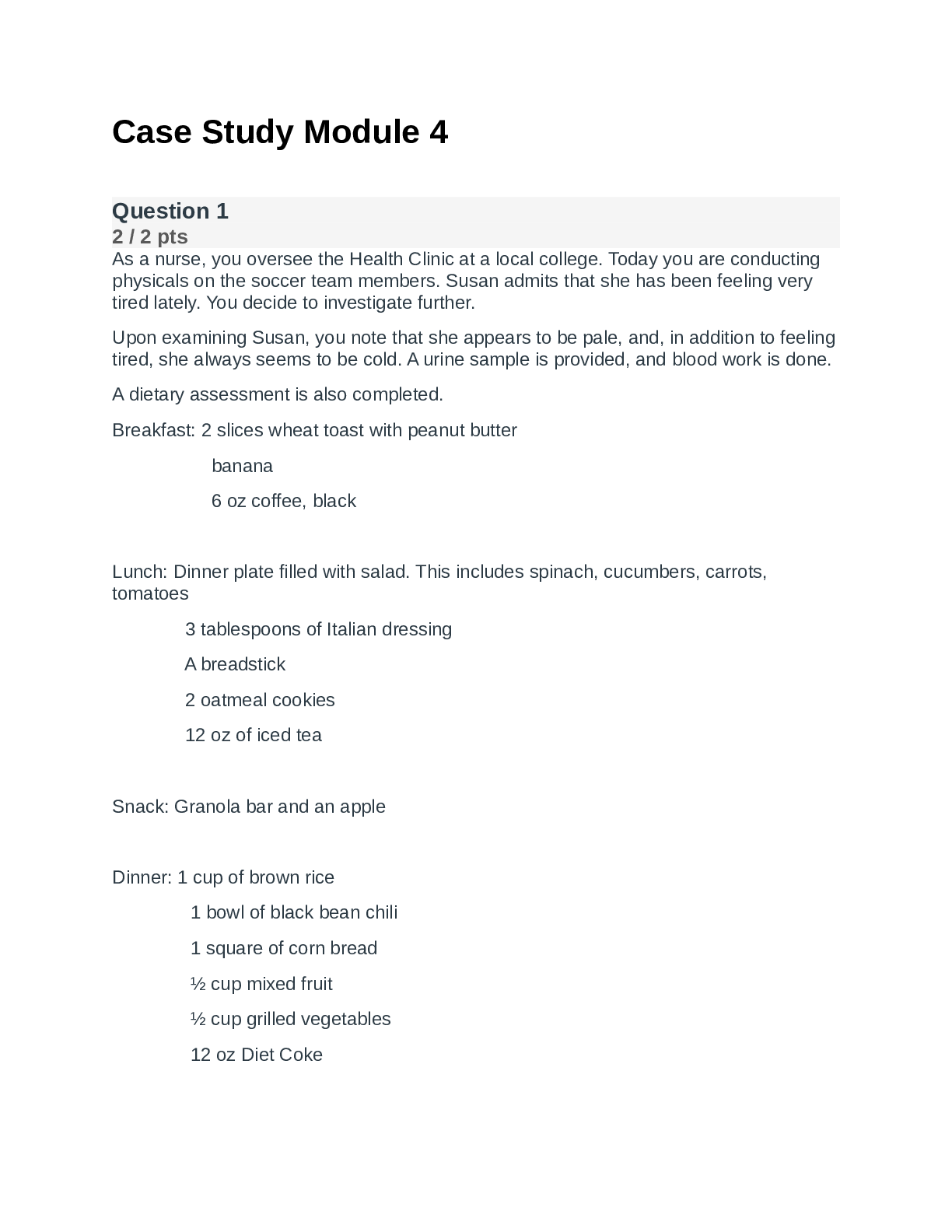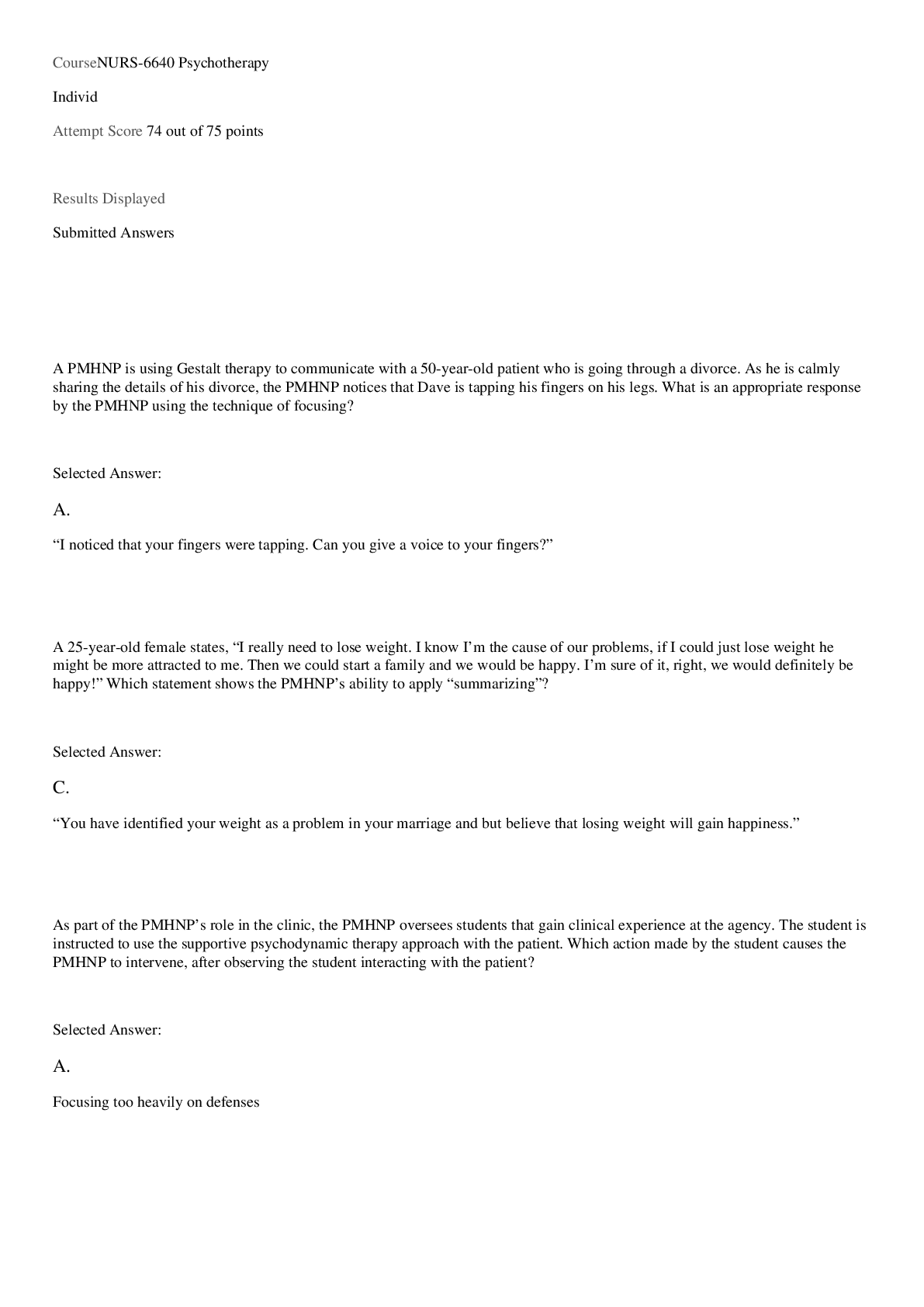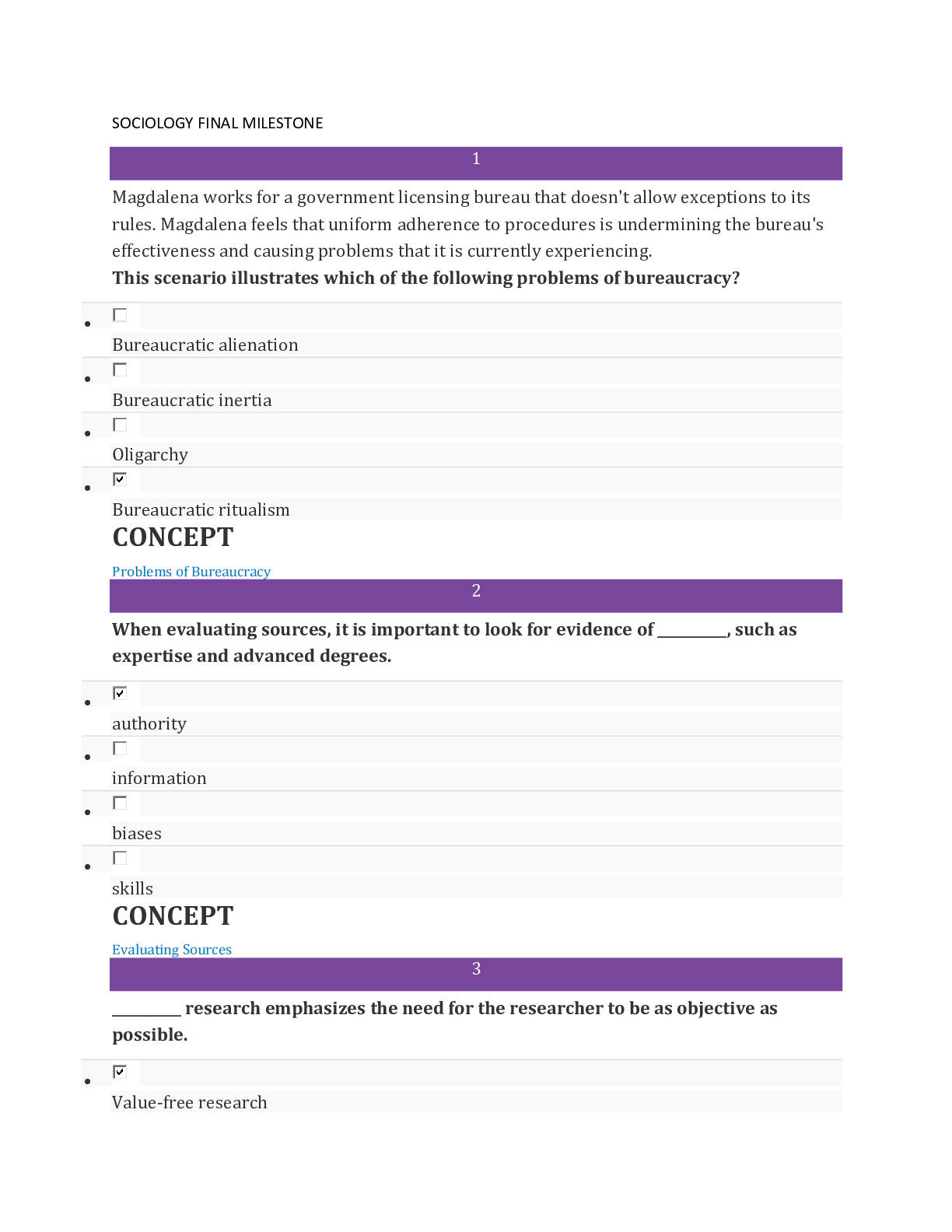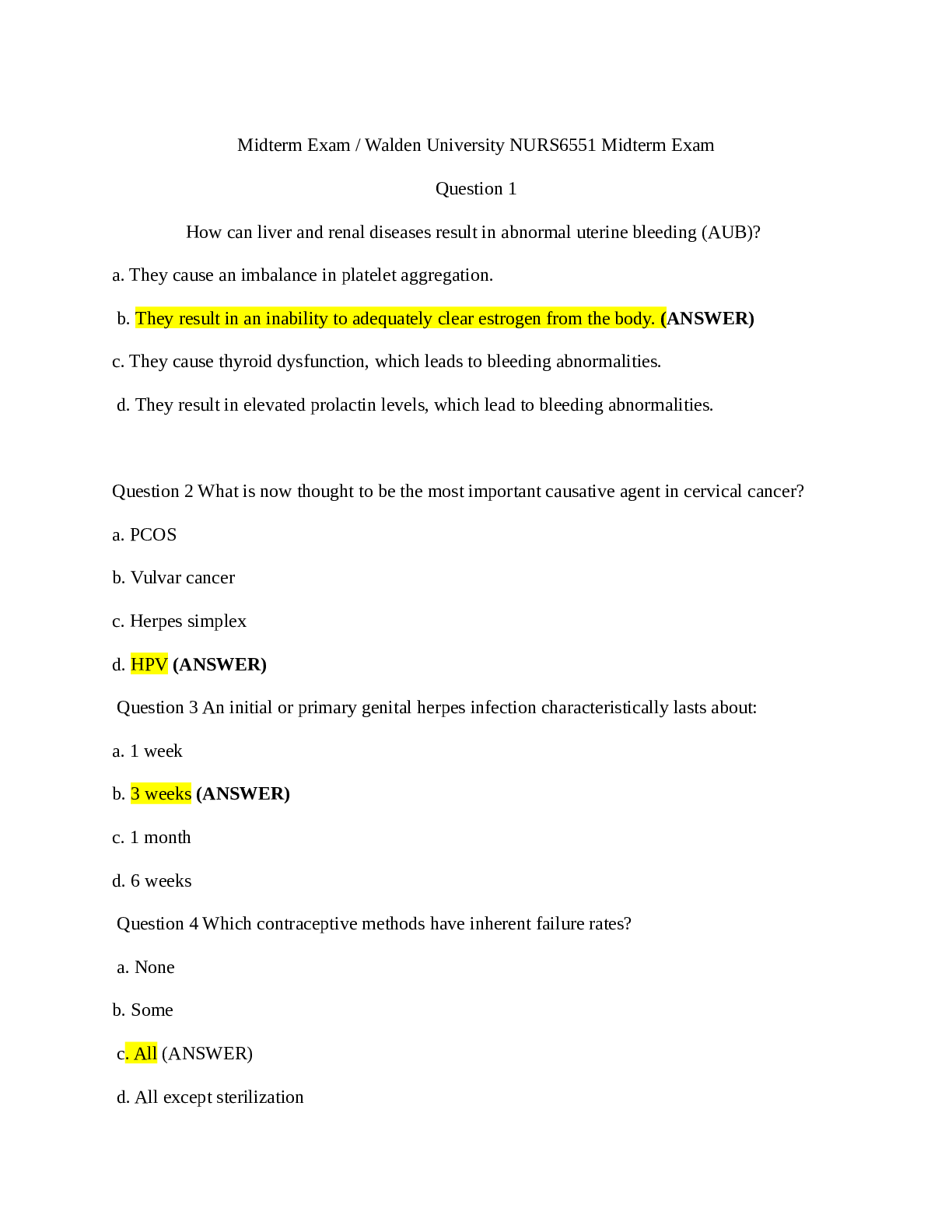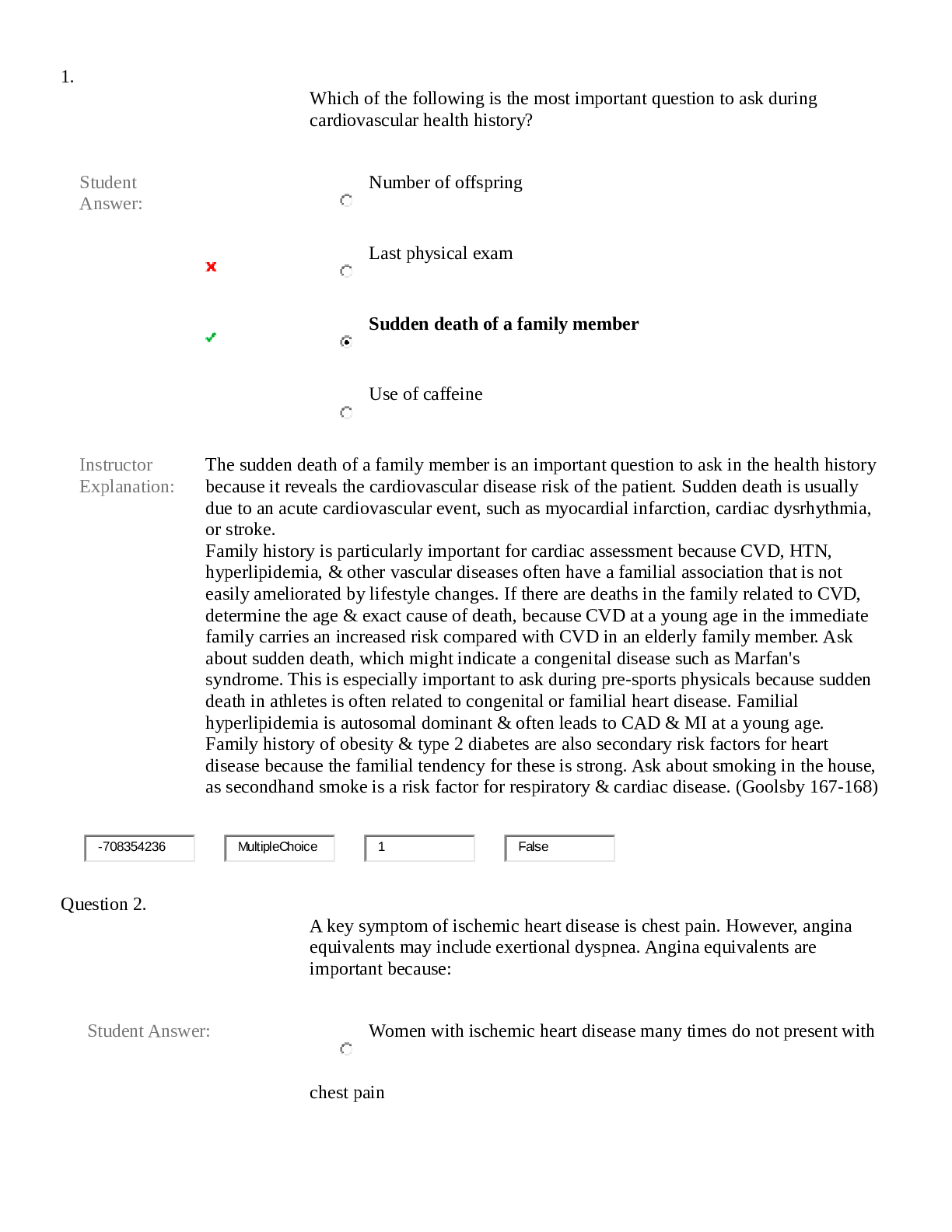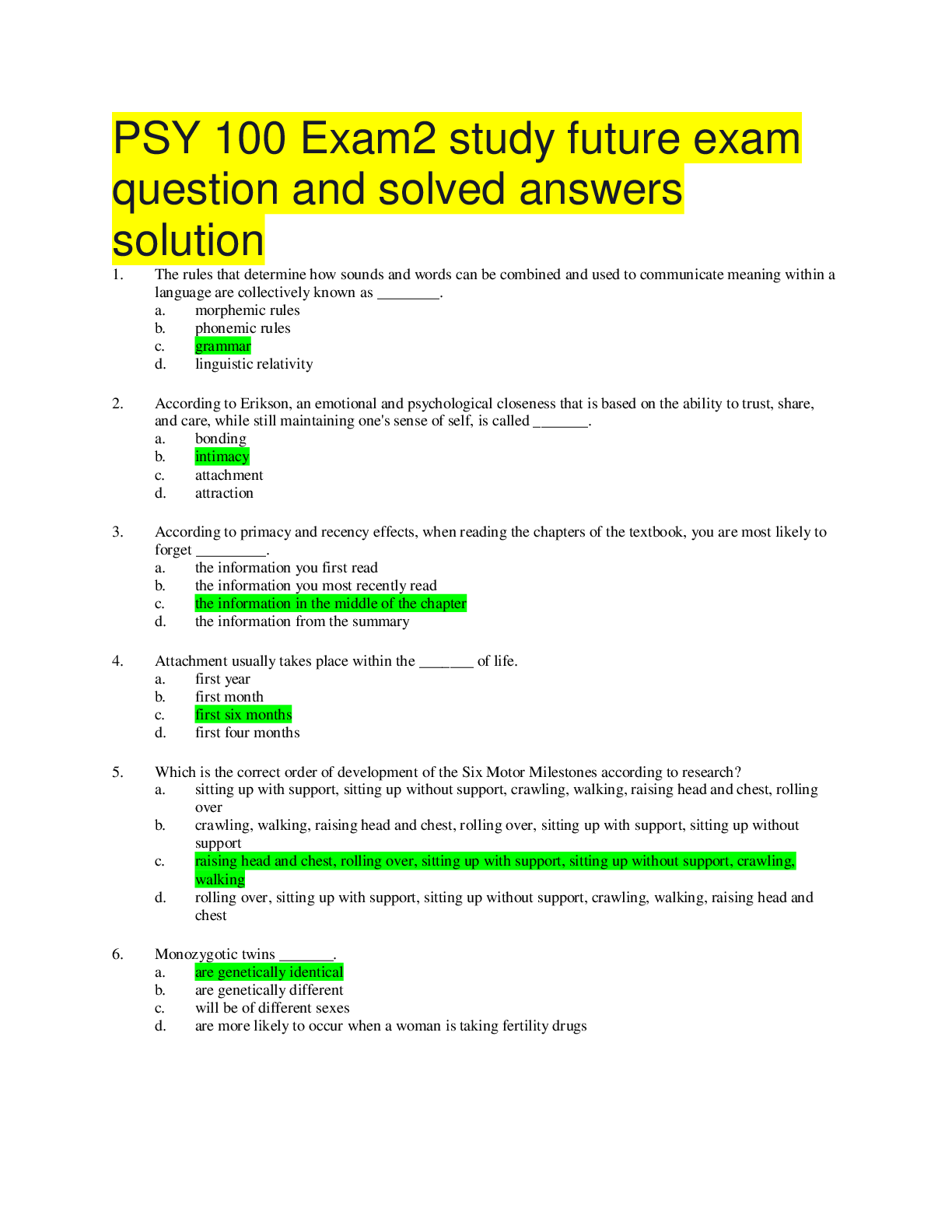*NURSING > QUESTIONS & ANSWERS > PSY 100 Exam2 study future exam question and solved answers solution (All)
PSY 100 Exam2 study future exam question and solved answers solution
Document Content and Description Below
PSY 100 Exam2 study future exam question and solved answers solution 1. The rules that determine how sounds and words can be combined and used to communicate meaning within a language are collective... ly known as ________. a. morphemic rules b. phonemic rules c. grammar d. linguistic relativity 2. According to Erikson, an emotional and psychological closeness that is based on the ability to trust, share, and care, while still maintaining one's sense of self, is called _______. a. bonding b. intimacy c. attachment d. attraction 3. According to primacy and recency effects, when reading the chapters of the textbook, you are most likely to forget _________. a. the information you first read b. the information you most recently read c. the information in the middle of the chapter d. the information from the summary 4. Attachment usually takes place within the _______ of life. a. first year b. first month c. first six months d. first four months 5. Which is the correct order of development of the Six Motor Milestones according to research? a. sitting up with support, sitting up without support, crawling, walking, raising head and chest, rolling over b. crawling, walking, raising head and chest, rolling over, sitting up with support, sitting up without support c. raising head and chest, rolling over, sitting up with support, sitting up without support, crawling, walking d. rolling over, sitting up with support, sitting up without support, crawling, walking, raising head and chest 6. Monozygotic twins _______. a. are genetically identical b. are genetically different c. will be of different sexes d. are more likely to occur when a woman is taking fertility drugs 7. A ________ reinforcer, such as money or praise, gets its value through an association with a(n) ________ reinforcer. a. positive; negative b. primary; secondary c. natural; artificial d. secondary; primary 8. What term do psychologists use to describe our tendency to search for evidence that supports our belief and to ignore evidence that might disprove it? a. confirmation bias b. convergent thinking c. availability heuristic d. representativeness heuristic 9. ________ is any relatively permanent change in behavior brought about by experience or practice. a. Learning b. Adaptation c. Memory enhancement d. Muscle memory 10. Gardner and his associates are known for proposing ________. a. the generalized theory of intelligence b. the triarchic theory of intelligence c. the theory of multiple intelligences d. the theory of emotional intelligence 11. Retroactive interference, as used in the study of memory, refers to when _________. a. older information already in memory interferes with the retrieval of newer information b. newer information interferes with the retrieval of older information c. information is not attended to and fails to be encoded d. information that is not accessed decays from the storage system over time 12. Trying to remember someone's name whom you met long ago is an example of what type of process? a. storage b. retrieval c. encoding d. decoding 13. Suppose Maria's mental age is 20 and her chronological age is 10. What is her IQ? a. 320 b. 80 c. 200 d. 100 14. Erikson saw the major challenge of young adulthood as that of _______. a. intimacy versus isolation b. generativity versus stagnation c. identity versus role confusion d. integrity versus despair 15. Which of the following is the proper sequence of symptom development in most cases of Alzheimer's disease? a. anterograde amnesia followed by retrograde amnesia¬ b. retrograde amnesia followed by proactive amnesia c. retroactive amnesia followed by anterograde amnesia d. retrograde amnesia followed by aneterograde amnesia 16. The researcher responsible for discovering classical conditioning was ________. a. Skinner b. Tolman c. Kohler d. Pavlov 17. In the process of fertilization, the _______ and _______ unite, resulting in a single cell. a. sperm; ovum b. zygote; sperm c. embryo; zygote d. ovum; fetus 18. The current view of why classical conditioning works the way it does, advanced by Rescorla and others, adds the concept of ________ to conditioning theory. a. generalization b. habituation c. memory loss d. expectancy 19. Learning that takes place without actual performance (a kind of latent learning) is called ________. a. the learning/performance distinction b. the innate performance preference c. the delayed learning paradigm d. the observational delay effect 20. Moishe can remember only the first two items and the last two items on the grocery list that his wife just read to him over the phone. The other five items in between are gone. This is an example of the _________. a. encoding specificity effect b. serial position effect c. TOT effect d. reintegrative effect 21. If one wanted to use the best method to get storage into long-term memory, one would use _________. a. maintenance rehearsal b. rote rehearsal c. elaborative rehearsal d. sleep learning 22. Which of the following is true of research on insight? a. Researchers have found that only human beings are capable of insight learning. b. Researchers have found support for the existence of both human and animal insight learning. c. Researchers have found that apes are capable of insight only after being taught this by humans. d. Researchers have proven that all creatures, even one-celled organisms such as the amoeba, are capable of insight learning. 23. Shelby is very adaptable to change. She is on a regular sleeping, eating, and waking schedule. Thomas and Chess would describe Shelby as being a(n) _______child. a. easy b. difficult c. slow-to-warm-up d. undemanding 24. A system for combining symbols so that an infinite number of meaningful statements can be made is called ________. a. pragmatics b. language c. semantics d. grammar 25. A male has a defect in the X chromosome of the 23rd pair. As children, people with this syndrome experience symptoms that can range from mild to severe or even profound intellectual disability. This is known as ________. a. fragile X syndrome b. Down syndrome c. fetal alcohol syndrome d. familial retardation 26. Memories for general facts and personal information are called _________. a. episodic memory b. procedural memories c. declarative memories d. factual memory 27. An advantage of algorithms over heuristics is that ________. a. algorithms are much faster b. algorithms guarantee a correct answer if one is available c. algorithms are shortcuts d. algorithms use rules-of-thumb 28. Which of the following statements about learning is NOT true? a. Learning is another word for "maturation." b. Learning is relatively permanent. c. Learning involves changes in behavior. d. Learning involves experiences. 29. The type of research design that compares various participants at several points in time to examine age-related differences and changes is called a _______. a. cross-sequential design b. longitudinal design c. behavior genetics design d. cross-sectional design 30. In which of the following cultures is a home destroyed if someone dies there, because there is a fear that there will be exposure to evil spirits? a. Navajo b. Sioux c. Apache d. Cheyenne 31. Based on the Loftus, et al. (1978) study, subjects viewed a slide presentation of an accident, and some of the subjects were asked a question about a blue car, when the actual slides contained pictures of a green car. When these same subjects were asked about the color of the car at the accident, they were found to be confused. This is an example of the _________. a. instant replay effect b. constructive processing effect c. levels-of-processing effect d. misinformation effect 32. According to Rescorla's theory, the CS must _______ the UCS or conditioning does not occur. a. replace b. come after c. appear simultaneously with d. predict 33. If memory were like the sea, we could say that _________ is long-term memory, _________ are the specific memories, and _________ are retrieval cues. a. the sea; fish; hooks b. a boat; worms; fish c. a boat; hooks; worms d. an island; worms; fishing poles 34. The Internet, with its series of links from one site to many others, is a good analogy for the organization of _________. a. short-term memory b. episodic memory c. long-term memory d. procedural memory 35. The levels-of-processing concept would suggest that which of the following questions would lead to better memory of the word frog? a. "Does it rhyme with blog?" b. "Is it in capital letters?" c. "Is it written in cursive?" d. "Would it be found in a pond?" 36. When people are asked to say how many windows they have in their dwelling, the amount of time people take to come up with the answer ________. a. doesn't depend on the number of windows b. depends on the number of windows c. depends on the size of the windows d. depends on whether the house had one or two stories, not the number of windows 37. In one study, over 2,500 photographs were shown to participants, one every 10 seconds. Participants were then shown pairs of photographs in which one member of each pair was one of the previously seen photographs. Accuracy for identifying the previously seen photos was _________. a. 10 to 20 percent b. 50 to 60 percent c. 70 to 80 percent d. 85 to 95 percent 38. Pavlov placed meat powder in the mouths of the dogs, and they began to salivate. Pavlov's student noticed that after a few days the dogs began to salivate at the sound of the student's footsteps. The salivation to the sound of the footsteps was a ________. a. primary reinforcer b. positive reinforcer c. conditioned response d. secondary reinforcer 39. Which of Erik Erikson's psychosocial crises revolves around the child's learning to direct his or her own behavior? a. trust versus mistrust b. initiative versus guilt c. industry versus inferiority d. autonomy versus shame and doubt 40. Mary and Juan are twins who developed from two separate fertilized ova that were fertilized by two different sperm. What type of twins are they? a. monozygotic twins b. maternal twins c. dizygotic twins d. wombmates 41. If a child is exposed to the "strange situation," then he or she _______. a. should receive immediate medical attention b. will view novel and eccentric stimuli c. will be in a room with other children that they don't know d. will be left with a stranger or alone in an unfamiliar situation 42. When adults who are speaking to infants change the pitch and rhythm in their speech, they are altering their ________. a. syntax b. grammar c. morphemes d. intonation 43. A researcher places dogs in a cage with metal bars on the floor. The dogs are randomly given electric shocks and can do nothing to prevent them or stop them. Later, the same dogs are placed in a cage where they can escape the shocks by jumping over a low hurdle. When the shocks are given, the dogs do not even try to escape. They just sit and cower. This is an example of ________. a. learned helplessness b. avoidance learning c. aversive conditioning d. vicarious learning 44. Which sense is the LEAST functional at birth? a. touch b. taste c. smell d. vision 45. Sally is enrolled in a high school geometry course, which she describes as "drawing figures and figuring drawings." In a typical class, students draw geometric figures and use a formula to calculate an aspect of the figure, such as its area. Each time Sally uses a formula, she is making use of what psychologists call ________. a. heuristics b. logarithms c. algorithms d. convergence 46. A characteristic that first shows up in the formal operational stage is _______. a. irreversibility b. egocentrism c. abstract thinking d. logical thinking 47. Which of the following statements BEST describes the general relationship between thinking and language? a. Language is a tool that may be used in thinking, but it isn't the sole basis of thought. b. Language is the sole basis of thought. c. When we think, we always make use of language. d. Language usually is not required in thought processes. 48. When given a list of items to remember, people tend to do better at recalling the last items on the list. This is known as the _________. a. phi phenomenon b. chunking effect c. recency effect d. primacy effect 49. Learning that occurs but is not immediately reflected in a behavior change is called ________. a. insight b. innate learning c. vicarious learning d. latent learning 50. The "aha!" experience is known as ________. a. latent learning b. insight learning c. thoughtful learning d. serial enumeration 51. What type of thinking could be described as taking different directions in search of a variety of answers to a question? a. decisive b. convergent c. heuristic d. divergent 52. At what point during infancy can babies tell the difference between their own mother's milk scent and another woman's milk scent? a. within a few days after birth b. within a few weeks after birth c. within a few months after birth d. within a year after birth 53. People are termed gifted in terms of intelligence if their IQ is above ________. a. 120 b. 130 c. 140 d. 150 54. Conditioned taste aversions are an example of something called __________. a. biological preparedness b. inherited conditioned dispositions c. long-term spontaneous recovery d. single repetition conditioning 55. Which of the following is NOT an example of operant behavior? a. a child doing her homework after she receives her teacher's approval for her behavior b. a rat pressing a bar after receiving food for this behavior c. a dog blinking its eyes after a flash of light is presented d. a rat pressing a bar after avoiding a shock for this behavior 56. Normally, when food is placed in the mouth of any animal, the salivary glands start releasing saliva to help with chewing and digestion. In terms of Pavlov's analysis of learning, salivation would be referred to as ________. a. an unconditioned response b. a voluntary response c. a conditioned response d. a digestive reflux 57. Information gets from sensory memory to short-term memory through the process of _________. a. elaborative rehearsal b. maintenance rehearsal c. automatic encoding d. selective attention 58. The correct formula for determining IQ as used in Terman's development of the Stanford-Binet Test was ________. a. MA/DA × 100 b. MA/CA × 100 c. MA/CA d. CA/MA × 100 59. Several weeks of diagnostic tests have revealed that cancer has spread throughout Barry's body. His physician suggested that he "take care of important matters." Barry realizes his family's home needs repairs, so he arranges to have that done right away. To relieve his family of the agony of planning his funeral, he has made all the arrangements. Barry tells his minister he has had a good life and just wants to make sure he provides for his family after his death. This description fits the stage Kübler-Ross called _______. a. denial b. acceptance c. bargaining d. depression 60. Neurofeedback, a newer type of biofeedback, involves trying to change ________. a. brain wave activity b. blood pressure c. heart rate d. body temperature 61. The system of rules that governs how we combine words to form grammatical sentences is called ________. a. syntax b. semantics c. morphology d. phonology 62. Unlike other schedules of reinforcement, ________ results in a "scalloped" pattern of responses on a cumulative frequency graph. a. fixed ratio b. fixed interval c. variable interval d. variable ratio 63. Which of the following is the term that refers to the difference between what a child can do alone and what that child can do with the help of a teacher? a. scaffolding b. conservation c. hypothetical thinking d. zone of proximal development 64. When the sound of the word is the aspect that cannot be retrieved, leaving only the feeling of knowing the word without the ability to pronounce it, this is known as _________. a. encoding failure b. extinction of acoustic storage c. auditory decay d. the tip-of-the-tongue phenomenon 65. When a stimulus is removed from a person or animal resulting in a decrease in the probability of response, it is known as ________. a. punishment by application b. punishment by removal c. negative reinforcement d. punishing reinforcement 66. Tim and Jim are identical twins who were raised apart. Ned and Ed are fraternal twins who were raised together. Which pair of twins will have more similar IQ scores, if either? a. Tim and Jim b. Ned and Ed c. It is impossible to answer based on the given information. d. All twins have the same IQ. 67. When newer information interferes with the retrieval of older information, this is called _________. a. cue-dependent forgetting b. proactive interference c. decay d. retroactive interference 68. Abe just got his driver's license. He loves to speed around town going more than 20 miles per hour above the speed limit. He believes that he can speed through red lights due to his perfect timing. This is an example of _______. a. underestimation b. personal fable c. self-serving bias d. imaginary audience 69. Shalissa is described as being tactful and able to manipulate situations to her advantage. She is probably high in ________. a. analytical intelligence b. creative intelligence c. practical intelligence d. none of these 70. According to Erikson, if a middle-aged person is unable to focus outward and is still dealing with issues of intimacy or even identity, that person is experiencing _______. a. generativity b. stagnation c. ego integrity d. despair 71. Getting paid for each basket of apples you gather represents which schedule of reinforcement? a. fixed interval b. fixed ratio c. variable ratio d. variable interval 72. Whereas Piaget saw cognitive development as a result of individual discovery and a child's interaction with objects, Vygotsky attributed cognitive development to _______. a. biological changes in the brain b. unconscious factors c. completing activities in isolation d. interaction between a child and skilled people 73. Applied behavior analysis (ABA) has been used to help children with autism. The basic principle of this form of behavior modification is ________. a. partial reinforcement b. classical conditioning c. negative punishment d. shaping 74. You decide that you are going to condition your dog to salivate to the sound of a metronome. You give the dog a biscuit, and then a second later you sound the metronome. You do this several times, but no conditioning seems to occur. This is probably because ________. a. the metronome was not a distinctive sound b. the metronome should have been sounded before the dog ate the biscuit c. you should have had a longer interval between the metronome and the biscuit d. Pavlov found that the CS and UCS must be only seconds apart in order to condition salivation 75. After Little Albert acquired a conditioned fear of rats, Watson wanted to see how he would react to a white rabbit, cotton wool, and a Santa Claus mask. He was studying whether or not ________ had occurred. a. behavior modification b. stimulus discrimination c. extinction d. stimulus generalization 76. The theory of adjustment to aging that assumes older people are happier if they remain active in some way, such as volunteering or developing a hobby, is called _______. a. activity theory b. wear-and-tear theory c. disengagement theory d. cellular clock theory 77. Evidence suggests that short-term memories are stored in the _________. a. cerebellum b. prefrontal lobes of the cortex c. hippocampus d. amygdala 78. An 8-year-old child who scored like an average 10-year-old on an intelligence test would have a mental age of ________ and an IQ of ________. a. 8; 80 b. 8; 125 c. 10; 100 d. 10; 125 79. Little Albert was conditioned to fear a ______. a. white mouse b. brown mouse c. white rat d. white puppy 80. Godden and Baddeley found that if you study on land, you do better when tested on land, and if you study underwater, you do better when tested underwater. This finding is an example of _________. a. memorability b. registered learning c. encoding specificity d. accessible decoding 81. Steve was born a male with an extra X chromosome on the 23rd pair. As result, he has reduced masculine characteristics, enlarged breasts, and is obese and excessively tall. Which disorder is likely to be diagnosed? a. PKU b. Down c. Klinefelter's d. Turner's 82. Malcolm, aged 35, is severely depressed. Because of this, he is given electroconvulsive shock therapy. After treatment, he is sent home and does much better. However, his TV-watching behavior is strange. Which is the most likely behavior pattern? a. Malcolm does not remember that he has a TV. b. Malcolm does not remember any episodes of shows going back 25 years. c. Malcolm thinks that last year's episodes of his favorite series are new. d. Malcolm can no longer understand long sentences if they occur in the dialogue. 83. In the parallel distributed processing model of memory, _________. a. information is simultaneously stored in a network that stretches across the brain b. information is stored simultaneously in unconnected regions of the brain c. information is associated in sets of classically conditioned neurons across the neocortex d. None of these are correct. 84. ________ intelligence has been suggested by Goleman to be a more powerful influence on life than more traditional views. a. Analytical b. Creative c. Emotional d. none of these 85. Let's say we could teach a dolphin to understand the difference between the sentences "The parrot kissed the dolphin" and "The dolphin kissed the parrot." If this were demonstrated, it might mean the dolphin had an understanding of ________. a. phonemes b. morphemes c. syntax d. pragmatics 86. Under what circumstances will a reinforcer make the target response more likely to occur again? a. if it is a primary reinforcer b. if it is a positive reinforcer c. if it is a negative reinforcer d. regardless of whether it is a positive or negative reinforcer, a reinforcer makes a response more likely to occur 87. In Erikson's _______ stage of psychosocial development, preschoolers are challenged to control their own behavior. a. trust versus mistrust b. autonomy versus shame and doubt c. initiative versus guilt d. industry versus inferiority 88. Chester is irritable, loud, and negative most of the time. He doesn't like it when new people pick him up, and he has irregular sleeping, eating, and waking schedules. What temperament does he exhibit? a. active b. slow-to-warm-up c. difficult d. easy 89. For observational learning to occur, each of the following must happen EXCEPT ______. a. paying attention to what the model does b. remembering what the model did c. doing what the model did d. being reinforced for imitating the model 90. A trait controlled by a dominant gene _______. a. will be expressed even when the corresponding gene in the other half of the pair is different b. will be expressed only if it is paired with two recessive genes c. will not be expressed if it is paired with another dominant gene d. will not be expressed when the corresponding gene in the other half of the pair is different 91. How many morphemes are there in the sentence "I wanted it"? a. four b. six c. five d. seven 92. Some research has found that several different species of fish—salmon, bluefin or albacore tuna, and swordfish—contain high levels of an omega-3 fatty acid called ________. This substance may help memory cells in the brain communicate with each other more effectively. a. DHA b. EDTA c. ghrelin d. leptin 93. When people hear a sound, their ears turn the vibrations in the air into neural messages from the auditory nerve, which makes it possible for the brain to interpret the sound. This process is called _________. a. encoding b. storage c. retrieval d. evaluation 94. Mary Ainsworth observed that securely attached infants _______. a. do not seem to care when the mother leaves the room and do not seek her out on her return b. protest loudly when the mother leaves, but resist contact with her when she returns c. cry if the mother leaves the room, are easily soothed, and welcome her back when she returns d. are not concerned upon separation, but cry to be picked up and held on her return 95. The theory in which aging is attributed to our bodies' organs and cell tissues simply wearing out with repeated use and abuse is called_______. a. activity theory b. wear-and-tear theory c. disengagement theory d. cellular clock theory 96. Around age 40, adults _______. a. see a decline in sexual functioning b. may need to wear bifocal lenses c. experience a sharpening of the senses d. do not experience any physical changes 97. False positives occur when a person incorrectly "matches" a stimulus that is merely similar to a real memory to that memory. One major problem with eyewitness testimony is that _________. a. extinction of auditory memories causes the witness to forget what was said b. witnesses are prone to habituate to the courtroom and forget what happened c. false positives can cause eyewitness testimony to be quite inaccurate d. None of these are true. 98. Pezdek and colleagues found that for a person to interpret thoughts and fantasies about false events as true memories, _________. a. the event must seem as vivid as possible b. the person must believe in hypnosis c. they must be plausible d. they must hear about the event several times 99. The communication between honeybees would not be classified as language because ________. a. bees are not animals b. bee communication seems to be instinctual c. bees do not use a spoken or auditory communication system d. none of these 100. Ryan has cystic fibrosis. This means that his mother is a carrier for the cystic fibrosis gene, while his father _______. a. is also a carrier b. is not a carrier c. does not have a cystic fibrosis gene d. has two cystic fibrosis genes 101. If a child successfully navigates this stage of psychosocial development, they will make decisions and act independently. a. integrity vs. despair b. autonomy vs. doubt c. initiative vs. guilt d. basic trust vs. mistrust 102. All parents think their little kids are geniuses. However, to be classified as a genius, the IQ score must be above ________. a. 120–125 b. 130–135 c. 140–145 d. 150–155 103. Watson's experiment with Little Albert demonstrated that fears might be __________. a. based on classical conditioning b. deeply rooted in the innate unconscious of infants c. based on the principle of observational learning d. based on Skinner's analysis of positive reinforcement 104. Skinner was to rats as Thorndike was to ________. a. cats b. rabbits c. dogs d. pigeons 105. Most standardized tests of intelligence have a distribution of scores that ________. a. follows the normal curve b. has a positive skew c. has a negative skew d. appears bimodal with two peaks of high frequency 106. A person is connected to an electroencephalograph, a machine that records the brain's electrical activity. The person is reinforced when his or her pattern of brain waves changes in order to treat a disorder such as epilepsy. This technique is best called _________. a. biofeedback b. behavior modification c. operant conditioning d. neurofeedback 107. A. R. Luria studied an individual with phenomenal memory. This person was a _________. a. gestaltiker b. hypnotist c. child prodigy d. mnemonist 108. It's Thanksgiving and the whole family has gotten together. You start to reminisce about your childhood and get into an argument with your brother. Both of you claim that you were the innocent victim of the other. This is an example of _________. a. constructive processing b. hindsight bias c. adaptation of memory traces d. flashbulb integration 109. The period of five to ten years during which a woman's reproductive system begins to decline is called _______. a. climacteric b. perimenopause c. menopause d. postmenopause 110. Which of the following criteria helps to increase the effectiveness of punishment? a. when it immediately follows the undesirable behavior b. when it is inconsistent c. when it is given with classical conditioning d. when it is vicarious 111. An important example of conditioned taste aversions might be ________. a. chemotherapy patients losing their appetites for food served around the same time they had their treatments b. farmers leaving out sheep meat laced with a nauseating substance for coyotes to find in hopes of teaching them not to eat sheep c. Both of these are examples of taste aversions. d. Neither of these are examples of conditioned taste aversions. 112. Pavlov's model of classical conditioning was based on the idea that the conditioned stimulus, through its association close in time with the unconditioned stimulus, came to activate the same place in the animal's brain that was originally activated by the unconditioned stimulus. This was known as ________. a. stimulus substitution b. the cognitive perspective c. the Skinner model d. higher-order conditioning 113. Thorndike was known for his work with ________. a. a Skinner box b. a puzzle box c. modeling d. monkeys 114. Kosslyn asked subjects if frogs have lips and a stubby tail. What did the subjects report? a. They visualized a frog, starting with the face ("no lips") and mentally rotated the image to look for the stubby tail. b. They visualized a frog, starting with the face ("no lips"), had it disappear, and then visualized a completely new frog for a second time with its backside to them. c. They knew the answer but did not have to generate an image. d. They felt that that task was impossible to accomplish. 115. The emotional bond that forms between an infant and a primary caregiver is called _______. a. temperament b. attachment c. trust d. habituation 116. Egbert is a quiet child who is very slow to adapt to change. However, if he is introduced gradually to new people or situations, then eventually he will accept them without too much distress. Thomas and Chess would say his temperament is _______. a. active b. slow-to-warm-up c. difficult d. easy 117. Which type of learning occurs when we observe how other people act? a. insight learning b. operant conditioning c. classical conditioning d. observational learning 118. College students faced with unsolvable problems eventually give up and make only half-hearted attempts to solve new problems, even when the new problems can be solved easily. This behavior is probably due to ______. a. learned helplessness b. contingency blocking c. latent learning d. response generalization 119. A researcher who selects a sample of people of varying ages and studies them at one point in time is, by definition, using the _______ method. a. cohort design b. longitudinal design c. behavior genetics design d. cross-sectional design 120. When Joe thinks about his sorely missed girlfriend, he drinks alcohol, which helps dull his feelings. This best illustrates: a. positive reinforcement. b. negative reinforcement. c. positive punishment. d. negative punishment. 121. Which of the following statements about heredity and intelligence is TRUE? a. Similarities in intelligence between identical twins who were separated at birth and raised in different houses must be due to heredity. b. Differences in intelligence between identical twins must be due to differences in their environments. c. If identical twins are separated at birth and raised in different homes, yet still have similar intelligence scores, the similarity in their scores must be due to hereditary influences. d. Prenatal influences have little, if any, influence on intelligence and need not be taken into account when studying environmental influences. 122. Which of the following statements about gifted people is true? a. They are more likely to suffer from mental illnesses. b. They are physically weaker than non-gifted persons. c. They are often skilled leaders. d. They are socially unskilled. 123. A seemingly arbitrary flash "out of the blue," through which the solution to a problem suddenly becomes apparent to you, but you do not consciously know how you "figured it out," is called ________. a. brainstorming b. priming c. insight d. a mental set 124. Brittany and Abby Hensel are _______. a. nonidentical twins b. dizygotic twins c. fraternal twins d. conjoined twins 125. A young boy is watching TV. In one show he sees a bully steal a lunch from another child. The bully then enjoys eating the other child's lunch. Because this boy feels that his mother makes him a rather skimpy lunch and he is always hungry at school, he starts stealing other kids' lunches at school. According to Bandura's theory of observational learning, his hunger at lunchtime most influenced which factor? a. attention b. memory c. imitation d. desire 126. Riley has figured out how to unlock his bedroom door with a paper clip. What has he most likely overcome in his new use of the paper clip? a. functional fixedness b. the representational problem c. the representative heuristic d. the confirmation bias 127. The scientific study of the changes that occur in people as they age from conception to death is called ________. a. abnormal psychology b. gerontology c. human development d. maturational studies 128. Which of the following theories sees aging as a process whereby cells are assumed to have a limitation on the number of times they can reproduce to repair damage? a. wear-and-tear theory b. cellular clock theory c. activity theory d. free radical theory 129. Professor Rashad is interested in studying cognitive development. He collects and compares data from a group of 6-year-olds and a group of 10-year-olds. Five years later, he compares these two groups to each other again as well as to their own performance in the study five years ago. What type of research design is Professor Grant using? a. cross-sequential design b. longitudinal design c. behavior genetics design d. cross-sectional design 130. The first step in the memory process is _________ information in a form that the memory system can use. a. encoding b. storing c. retrieving d. evaluating 131. In contrast to Piaget, Vygotsky emphasized the role of _______ during development. a. learned responses b. social and cultural interactions c. individual differences d. the child's representations of the world 132. Learning is said to be a relatively permanent change in behavior because ________. a. it is thought that learning changes the nerve fiber patterns in your muscles b. once you learn something, you will never fail to remember it or carry out the correct action c. it is thought that when learning occurs, some part of the brain physically changes d. memory processes, unlike learning processes, are not permanent 133. Which letters correspond to the four elements of modeling from Bandura's theory? a. MIMA b. AMID c. BANDURA d. MOMA 134. The trial-and-error method of solving problems is also known as ________. a. the use of a heuristic device b. the use of algorithms c. the mechanical solution d. the A.I. solution 135. A special molecule, _______, contains the genetic material of the organism. a. DNA b. a gene c. a chromosome d. an amine 136. Some researchers believe that classical conditioning takes place only because: a. the pairing of the CS and US does not provide useful information about the likelihood of occurrence of the US. b. the pairing of the CS and UR provides useful information about the likelihood of occurrence of the CS. c. the pairing of the CS and US provides useful information about the likelihood of occurrence of the US. d. the pairing of the US and UR provides information about the likelihood of occurrence of the US. 137. _______ refers to heredity and _______ refers to environmental influences. a. Nature; nurture b. Cognition; emotion c. Nurture; behavioral genetics d. Cross-sectional; longitudinal 138. Which of the following statements about flashbulb memories is true? a. Flashbulb memories tend to be about as accurate as other types of memories. b. People feel unconfident about their recall of flashbulb memories. c. A major news event automatically causes a person to store a flashbulb memory. d. Your memory of how you felt at the onset of a flashbulb memory rarely changes over time. 139. Diseases carried by recessive genes are inherited when _______. a. a child inherits two recessive genes, one from each parent b. a child inherits two dominant genes, one from each parent c. a child inherits a dominant gene from one parent and a recessive gene from the other parent d. the child doesn't inherit any genes from one parent 140. A farmer is being troubled by coyotes eating his sheep. In an attempt to solve the problem, he kills a sheep and laces its body with a nausea-inducing drug. He leaves the sheep out where he knows the coyotes roam. He hopes they will learn to not eat the sheep. The farmer is attempting to apply the research of ________ to accomplish this. a. Bandura b. Skinner c. Tolman d. Garcia 141. In the semantic network model of memory, concepts that are related in meaning _________. a. are not physically proximal b. are archaic c. are stored physically closer to each other than concepts that are not highly related d. All of these are true. 142. Gardner's theory of multiple intelligences divides intelligence into ________ independent abilities. a. three b. five c. seven d. nine 143. _________ is the tendency for older or previously learned material to interfere with the retrieval of newer, more recently learned material. a. Cue-dependent forgetting b. Proactive interference c. Decay d. Retroactive interference 144. The fact that it is easier to recall items at the beginning and end of a list of unrelated items is known as the _________. a. phi phenomenon b. implicit memory effect c. serial position effect d. sequestering effect 145. Silvia has blond hair, even though her mother and father each have brown hair. What do we know about Silvia's parents? a. At least one of her parents has a recessive gene for blond hair. b. Each of her parents must have one recessive gene for blond hair color. c. Each of her parents must have one dominant gene for blond hair. d. Neither of her parents has a gene for blond hair. 146. You try to remember a phone number by repeating it over and over to yourself. What type of rehearsal are you using? a. condensed b. permanent c. elaborative d. maintenance 147. Sue noticed that whenever she opened the door to the pantry, her dog would come into the kitchen and act hungry, by drooling and whining. She thought that because the dog food was stored in the pantry, the sound of the door had become a(n) ________. a. unconditioned stimulus b. conditioned stimulus c. unconditioned response d. conditioned response 148. A young child watches her mother make pancakes. She wants to please her mother so she pays attention. However, when she goes to make them on her own, she can't break the eggs for the batter without making a terrible mess and dropping them on the floor, no matter how hard she tries. Her attempt failed because of a problem with which part of the necessary components for observational learning? a. attention b. memory c. imitation d. desire 149. Having a high IQ doesn't always guarantee success. Terman and Oden examined the most and least successful men in their sample of gifted individuals. The most successful were ________. a. more goal-oriented and persistent b. introverted c. less interested in social relationships d. none of these 150. What could John Watson have done to eliminate Little Albert's conditioned fear? a. Show Albert a toy dog instead of a live rat. b. Let Albert touch a Santa Claus beard repeatedly. c. Show Albert a rat many times without a loud noise following so that extinction would occur. d. Have Albert hear a loud noise many times without a rat present. 151. A Skinner box is most likely to be used in research on ________. a. classical conditioning b. operant conditioning c. vicarious learning d. cognitive learning 152. Which of the following statements is TRUE about Terman's longitudinal study of gifted children? a. The same children were followed over the length of their life span, and some are still being followed today. b. Gifted people of different ages were all studied at once and their personal values compared. c. The gifted were found to be socially awkward and had little social success in life. d. none of these 153. Jean Piaget is noted for his theory of _______. a. cognitive development b. perceptual development c. language development d. motor development 154. The tendency to respond to a stimulus that is similar to the original conditioned stimulus is called ________. a. stimulus generalization b. stimulus adaptation c. response generalization d. transfer of habit strength 155. Karawynn Long attempted to toilet train her cat. The principle of learning that was in operation was ________. a. observational learning b. classical conditioning c. AMIM d. shaping 156. Moishe can remember only the first two items and the last two items on the grocery list that his wife just read to him over the phone. The other five items in between are gone. His memory of things at the end of the list demonstrates the __________. a. encoding specificity effect b. primacy effect c. recency effect d. TOT effect 157. According to Robert Sternberg, ________ intelligence is the ability to deal with new and different concepts and to come up with new ways of solving problems (divergent thinking, in other words). a. analytical b. creative c. practical d. existential 158. Which theorist proposed the cognitive perspective that explains that classical conditioning occurs because of expectancy? a. Pavlov b. Garcia c. Rescorla d. Skinner 159. Amy is 30 years old and she has difficulty forming meaningful relationships with others. According to Erikson, she is most likely in the _______ stage. a. intimacy vs. isolation b. identity vs. role confusion c. basic trust vs. mistrust d. integrity vs. despair 160. In order to treat a child's attention problems in a classroom, a technique that uses the EEG and video game-style technology called ________ has been employed. a. neurogenetics b. neurofeedback c. biofeedback d. videographics 161. A(n) _______ is a section of DNA containing a sequence of amines. a. compound b. gene c. chromosome d. amine 162. The growth spurt for girls typically begins at what age? a. 9 b. 12 c. 10 d. 15 163. Piaget's term for the knowledge that an object exists even when it is out of sight is _______. a. conservation b. object permanence c. centration d. egocentrism 164. Which of the following is an example of a test using recall? a. short answer b. essay c. fill-in-the-blank d. All of these are examples that use recall. 165. An advantage of using a heuristic over an algorithm is ________. a. the heuristic ensures a correct answer b. the heuristic takes longer and is more accurate c. the heuristic can be quicker d. the heuristic always works the same way 166. On a newly developed IQ test, an individual scores at the 110 level on the first half of the test, and 150 on the second half of the test. What does this test appear to lack? a. reliability b. standardization c. predictive validity d. appropriate norms 167. Suzy looks up from her lunch, realizing that Jacques has just said something to her. What was it? Oh, yes, he has just asked her if she wants to go to the movies. Suzy's ability to retrieve what Jacques said is due to her _________. a. iconic sensory memory b. echoic sensory memory c. short-term memory d. tactile sensory memory 168. What are the two major types of rehearsal (for moving information from short-term to long-term memory)? a. condensed and expanded b. elaborative and permanent c. maintenance and permanent d. elaborative and maintenance 169. The words "care" and "bear" differ in one ________. a. morpheme b. phoneme c. gesture d. syntax 170. Marisa is at a point in her pregnancy when the zygote is moving down to her uterus, and the placenta and umbilical cord are beginning to form. Which period of prenatal development is Marisa currently experiencing? a. fetal b. embryonic c. placental d. germinal 171. Which of the following is NOT one of the three types of temperament described by Thomas and Chess? a. active b. slow-to-warm-up c. difficult d. easy 172. Your little brother has a big ball of clay. While he watches, you roll the ball of clay into a long snake-like shape. He begins to cry because he thinks he has less clay now. Which of Piaget's stages is your brother likely to be in? a. sensorimotor b. preoperational c. formal operational d. concrete operational 173. Learning to make a reflex response to a stimulus other than to the original, natural stimulus is called ________. a. classical conditioning b. operant conditioning c. memory linkage d. adaptation 174. One problem with relying on eidetic imagery to study for tests is that _________. a. you remember too much material and the professor will think you are cheating b. eidetic images fade in .25 seconds as Sperling has shown c. you may be able to recall the material but you don't necessarily understand it d. it only helps you remember things from other cultures 175. The divergent thinking technique of writing down everything that comes to mind about a topic without revising or proofreading until all of the information is recorded, and then organizing it later, is known as ________. a. brainstorming b. keeping a journal c. freewriting d. mind or subject mapping 176. In the game show Jeopardy! contestants are tested on general information. The type of memory used to answer these kinds of questions is _________. a. procedural b. semantic c. episodic d. working 177. Rod-shaped structures in the cell nucleus that contain genes are referred to as _______. a. DNA b. sex-linked traits c. chromosomes d. amines 178. In Piaget's theory, the stage of cognitive development between 7 and 12 years of age, in which an individual becomes capable of logical thought processes but is not yet capable of abstract thinking, is the _______ stage. a. concrete operations b. sensorimotor c. preoperational d. formal operations 179. Which was NOT a finding of the Terman and Oden (1947) study of gifted kids? a. They were socially well adjusted. b. They were more resistant to mental illness. c. They were clearly much more likely to be females. d. They were above average in weight, height, and physical attractiveness. 180. Adrianna is trying to memorize the names of the bones in the hand. She had gone through a list of them when her phone rang. After she gets off the phone, she is MOST likely to remember the first few bone names because of the _________. a. elaboration effect b. recency effect c. primacy effect d. maintenance effect 181. The correct sequence of the five stages of death and dying postulated by Kübler-Ross is _______. a. denial, anger, bargaining, depression, and acceptance b. denial, anger, bargaining, acceptance, and depression c. anger, denial, bargaining, acceptance, and depression d. anger, denial, bargaining, depression, and acceptance 182. Which of the following is a desirable characteristic of culture-fair tests? a. They should minimize or eliminate the use of language. b. They should not attempt to measure intelligence. c. They should be composed of items that vary from culture to culture. d. They should measure values based on a person's cultural background. 183. Kelsey just told her family a really funny joke that she made up herself. In order to use a primary reinforcer to encourage her in her joke-telling, Kelsey's dad might ________. a. offer her money b. applaud her appropriate behavior c. offer her praise for a job well done d. offer her a piece of candy 184. The placenta is _______. a. the tube through which a developing baby receives nourishment b. the technical name for the "belly button" c. a specialized organ that provides nourishment and filters away waste products from the developing baby d. the name for the developing organism until it is 8 weeks old 185. Little Albert's acquired fear of a white rat was a classic example of a(n) ________ response. a. classical counterconditioned b. conditioned emotional c. positively reinforced d. negatively reinforced 186. Which type of attachment style is characterized by babies who do not seem to care very much whether the mother is present or absent, and are equally comfortable with her and a stranger? a. secure b. avoidant c. resistant d. disorganized 187. Conflicts between adolescents and their parents tend to be over _______. a. trivial things b. moral issues c. political issues d. major things 188. An animal is conditioned to salivate to a metronome using Pavlovian procedures. After the conditioning is established, the animal is then put through an extinction procedure and the conditioned salivation disappears. Then the animal is removed from the test situation for several days. When returned to the test situation, the conditioned response is seen again. The effect is known as ________. a. spontaneous recovery b. higher-order conditioning c. extinction d. stimulus generalization 189. "If a response is followed by a pleasurable consequence, it will tend to be repeated. If a response is followed by an unpleasant consequence, it will tend not to be repeated." This is a statement of ________. a. the Law of Positive Reinforcement b. Rescorla's cognitive perspective c. Thorndike's Law of Effect d. Garcia's conditional emotional response 190. Which learning theorist is responsible for the discovery of conditioned taste aversions? a. Seligman b. Garcia c. Skinner d. Watson 191. Which is the most likely prototype for the concept "vehicle"? a. glider b. car c. scooter d. bicycle 192. Mark and Kathy take their 2-year-old son to the supermarket every Saturday. Each week, the same sequence of events unfolds: Their son screams, demanding that they buy him treats. Although they refuse to give in to his demands, he continues to scream. Finally, either Mark or Kathy gets in their son's face and yells at the top of their lungs "Shut up!" He stops screaming instantly. What operant conditioning concepts are illustrated in this story? a. The parents are using negative reinforcement to increase their son's screaming. b. The parents are in a very dysfunctional marriage; their child's screaming is his way of trying to get his parents to remain married. c. The parents are using punishment to suppress the screaming; their use of punishment is negatively reinforced by the cessation of screaming. d. Their son probably learned how to scream by observing his parents at home, and now he is reinforced on a variable-interval schedule of reinforcement. 193. For which famous memory researcher is memory a problem-solving activity in which the problem is to give a coherent account of some past event, and the memory is the solution to that problem? a. Bartlett b. Meyer c. Ebbinghaus d. Skinner 194. Human beings generally have an aversion to bitter and sour foods. Some researchers suggest that this is because foods that are inedible or even poisonous are often bitter or sour. The tendency of human beings to find these potentially harmful foods repulsive is an example of ________. a. classical conditioning b. vicarious conditioning c. conditioned emotional response d. biological preparedness 195. The system of rules that governs how we assign meaning to the morphemes we use is called ________. a. syntax b. semantics c. phonology d. regularization 196. Which schedule of reinforcement tends to get the highest response rate? a. fixed interval b. variable ratio c. variable interval d. fixed ratio 197. In Bandura's study of observational learning, the abbreviation AMID stands for ________. a. attention, memory, imitation, desire b. alertness, motivation, intent, monetary reward c. achievement, momentum, initiative, memory d. achievement, motivation, intellectual capacity, memory 198. According to Gilligan, Kohlberg's theory of moral development: a. should only be applied to males. b. explains moral reasoning in multiple cultures. c. should be extended to males. d. is a comprehensive theory without missing components. 199. Which of the following examples represents the shallowest processing as described by the levels of processing model? a. recalling an object's function b. attending to the sound of a word c. thinking about the meaning of a word d. recalling that an object was rectangular 200. A child from which of the following parenting types would be most likely to lack social skills later in life? a. ambivalent b. authoritative c. authoritarian d. permissive 201. PET scans have demonstrated that when you are creating a visual image, ________. a. the image is generated by the retinal ganglion cells and sent to the cortex b. the image is generated by the thalamus and sent to the brain c. the areas associated with stored knowledge send information to the visual cortex d. there is no locus in the brain that can be determined for the generation of visual images 202. Times when certain internal and external influences have a major impact on development are called _______. a. fetal periods b. critical periods c. germinal periods d. latency periods 203. If intelligence is determined primarily by heredity, which pair should show the highest correlation between IQ scores? a. fraternal twins b. identical twins c. brothers and sisters d. parents and children 204. In an experiment, two groups of dogs are given shocks to their feet. One group is able to escape the shocks by jumping over a barrier. The second group is harnessed and cannot escape. After several trials, both groups are put in situations where they CAN escape. The first group escapes the shocks but the second group just sits and whines, refusing to attempt to escape. The response of the second group is due to ______. a. learned helplessness b. contingency blocking c. latent learning d. response generalization 205. Vision is not very well developed at birth. As a result, which statement is NOT true about vision at birth? a. Color and vision acuity takes approximately 6 months to develop more clearly from birth. b. Newborns have a clear vision field of 12–14 inches at birth. c. Newborns prefer to look at 3-dimensional objects versus 2-dimensional. d. Newborns prefer to look at complex patterns and also the human face than other stimuli. 206. Germain tends to rule his home with an iron fist. His children know the rules and they are expected to obey them without question, or there will be harsh consequences. Diana Baumrind would describe Germain's parenting style as _______. a. authoritarian b. authoritative c. ironclad d. indulgent 207. The first thing that comes to mind when asked to name an example from a category is called the ________. a. schema b. prototype c. concept marker d. category marker 208. The most likely cause for miscarriage during the first three months of pregnancy is _______. a. a genetic defect b. alcohol use c. not taking prenatal vitamins d. lack of exercise 209. Bandura conducted a classic study known as the "Bobo" doll study. The term Bobo refers to ________. a. Bandura's pet name for the dog used in the study b. Bandura's loyal but strange assistant that carried out the study c. Bandura's nickname that his wife had given him d. the type of inflatable doll that was used in the study 210. Your memory of the moment you heard about the planes crashing into New York's Twin Towers on September 11, 2001 would be most appropriately termed a(n) _________ memory. a. episodic b. autobiographical c. flashbulb d. repressed 211. Which of the following cognitive abilities declines during adulthood? a. intellectual abilities b. speed of processing c. wisdom d. verbal ability 212. What was Mary Ainsworth trying to determine when she devised an experimental method called the "strange situation"? a. the nature of gestural communication between mothers and babies b. aspects of purposeful exploration as the baby investigates a strange environment c. parental discipline styles in the first year of life d. the nature of attachment between caretakers and babies 213. The concept of the confirmation bias specifically assumes that we are most likely to believe ________. a. the scientific method as true b. information that agrees with our thinking c. information that refutes our thinking d. logical thinking 214. Which of the following statements is TRUE? a. All memories are stored in one place in the brain. b. Memories are randomly distributed throughout the brain. c. Different parts of the brain are specialized for the storage of memories. d. Almost all memories are primarily stored in the brain stem. 215. Which of these is an element of the formal definition of intellectual disability? a. adaptive behavior severely below a level appropriate for the person's age b. evidence of brain damage c. slower than normal reflexes d. onset of deficits prior to age 6 216. The case of Father Bernard Pagano, who was identified by seven eyewitnesses as a criminal, was an instance of a _________. a. tip-of-the-tongue effect b. retrieval failure c. primacy effect d. false positive 217. In the levels-of-processing model of memory, information that gets processed at a _________level (such as accessing the meaning of a word or phrase) is more likely to be retained longer and form a stronger memory than information that is processed at a _________ level (such as the visual characteristics of a word). a. deeper; shallower b. shallower; deeper c. higher; lower d. lower; higher 218. Which of the following statements is true about behavior modification? a. It involves the process of shaping. b. It is useful only for teaching autistic children. c. It is different from behavior modification. d. It cannot be used with animals. 219. Many middle-aged adults can vividly recall where they were and what they were doing the day that John F. Kennedy was assassinated, although they cannot remember what they were doing the day before he was assassinated. This is an example of _________. a. an eidetic image b. a flashbulb memory c. a semantic memory d. a procedural memory 220. Dallas is a 10-year-old boy who has a mental age of 10 years. His IQ would be ________. a. 80 b. 100 c. 115 d. 130 221. Researchers have found that, despite the number of color names in a language, the basic abilities to perceive color are unchanged. This finding would be troublesome for the theory of ________. a. Piccard and Worf b. Sapir and Whorf c. Skinner and Watson d. Tolman and Thorndike 222. What did Terman's groundbreaking study of gifted children accomplish? a. It put to rest the myths that existed about genius in the early part of the twentieth century. b. It proved that gifted children and adults are more prone to mental illnesses or odd behavior than other groups. c. It demonstrated that they also have more than their share of failures. d. It demonstrated that genius is the only factor that influences real success in life. [Show More]
Last updated: 1 year ago
Preview 1 out of 30 pages
Instant download
.png)
Instant download
Reviews( 0 )
Document information
Connected school, study & course
About the document
Uploaded On
Dec 09, 2020
Number of pages
30
Written in
Additional information
This document has been written for:
Uploaded
Dec 09, 2020
Downloads
0
Views
32




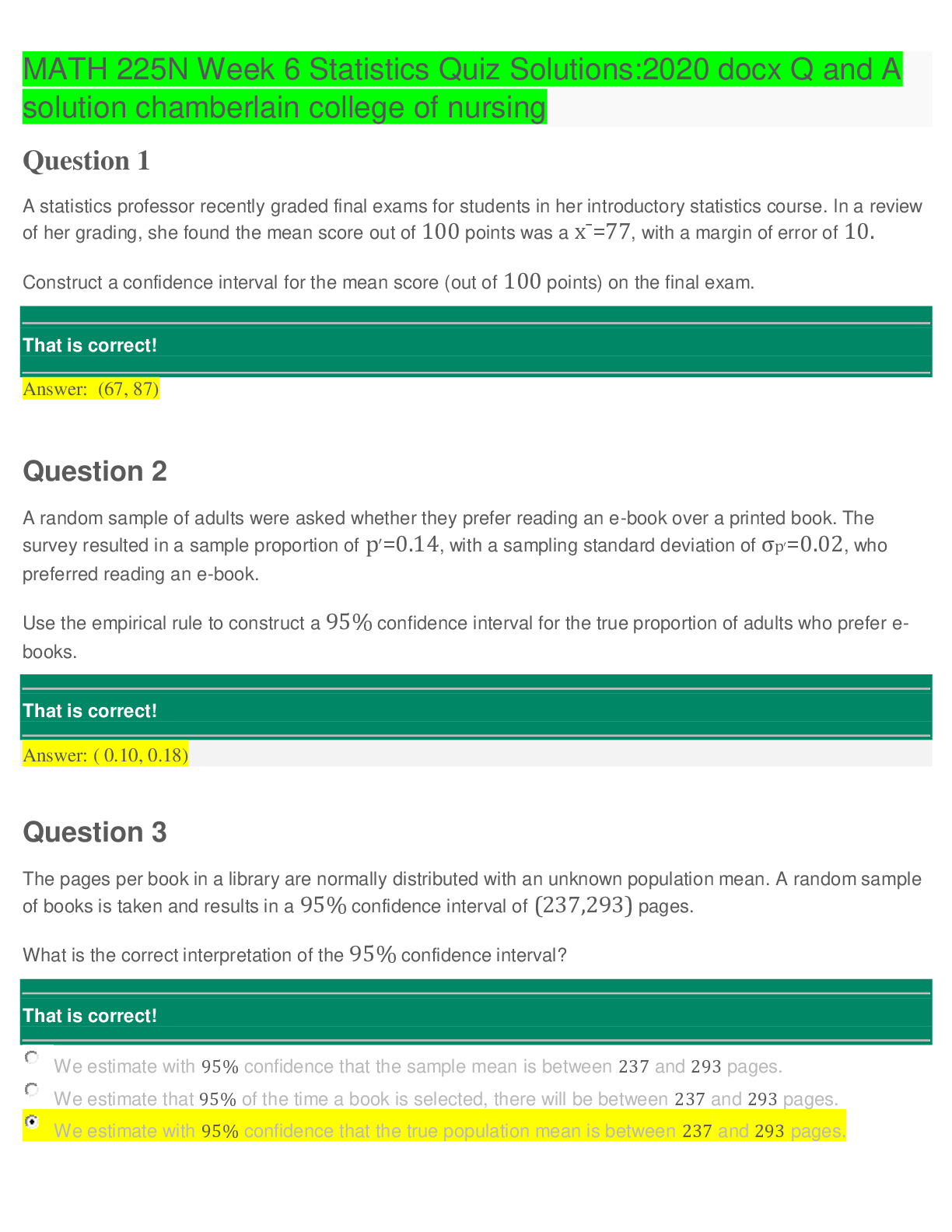

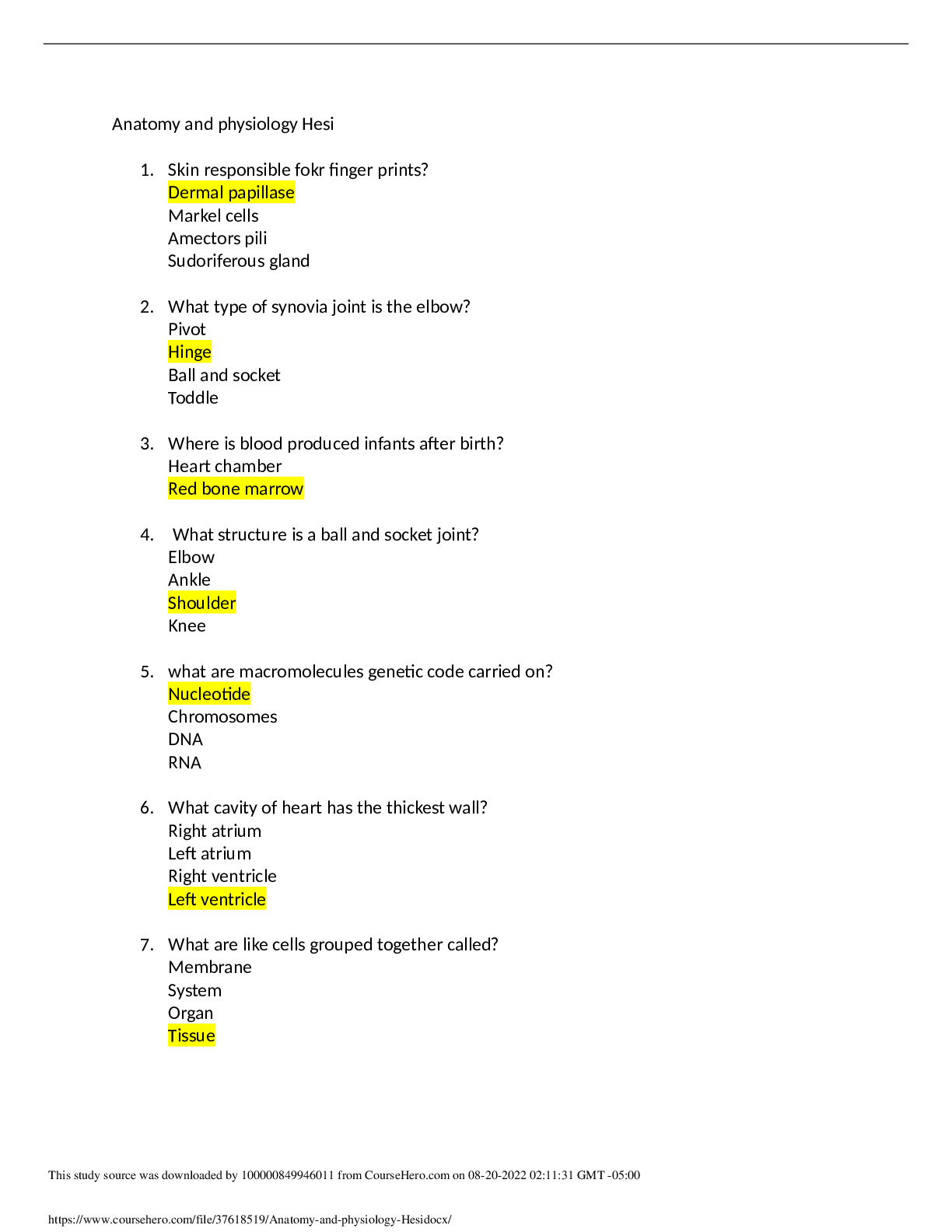

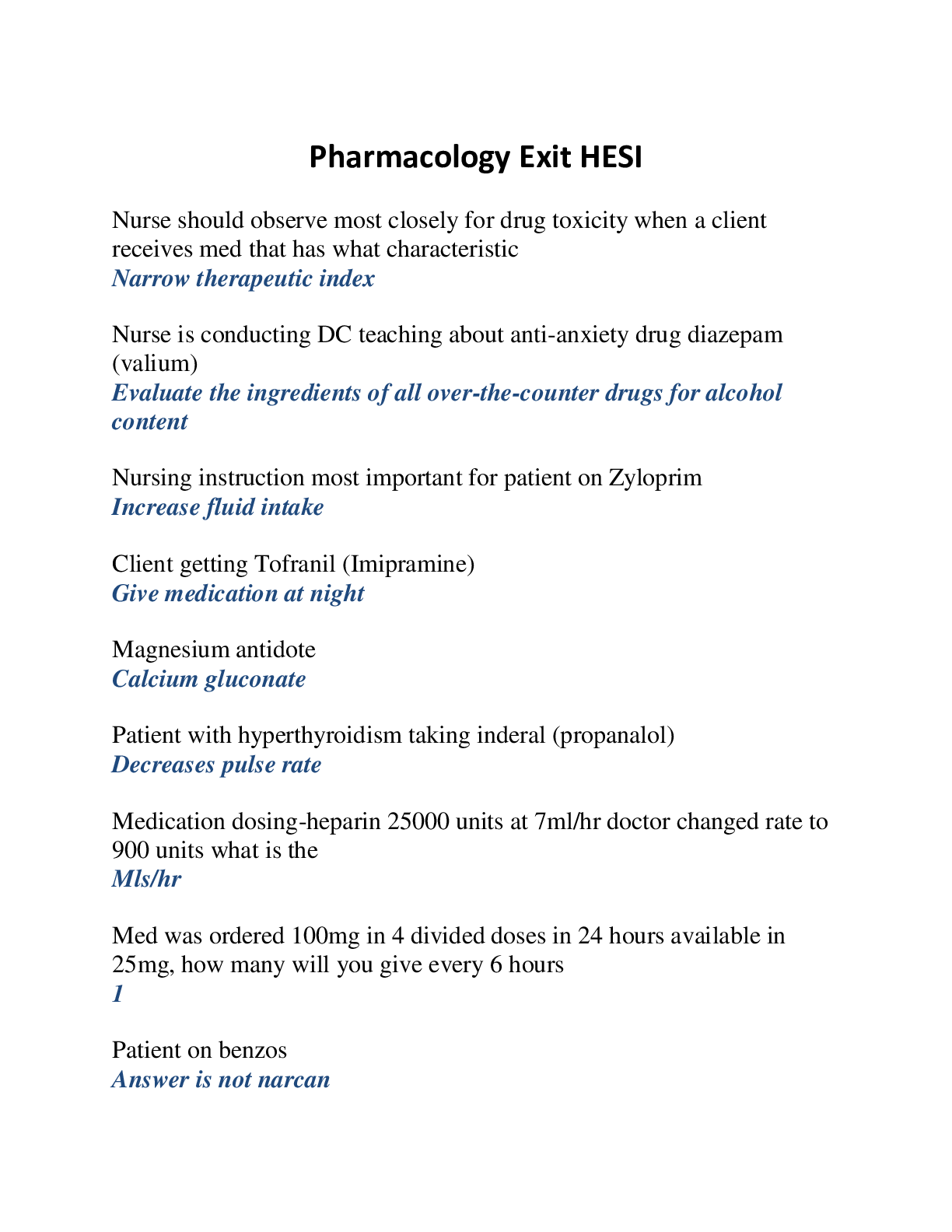
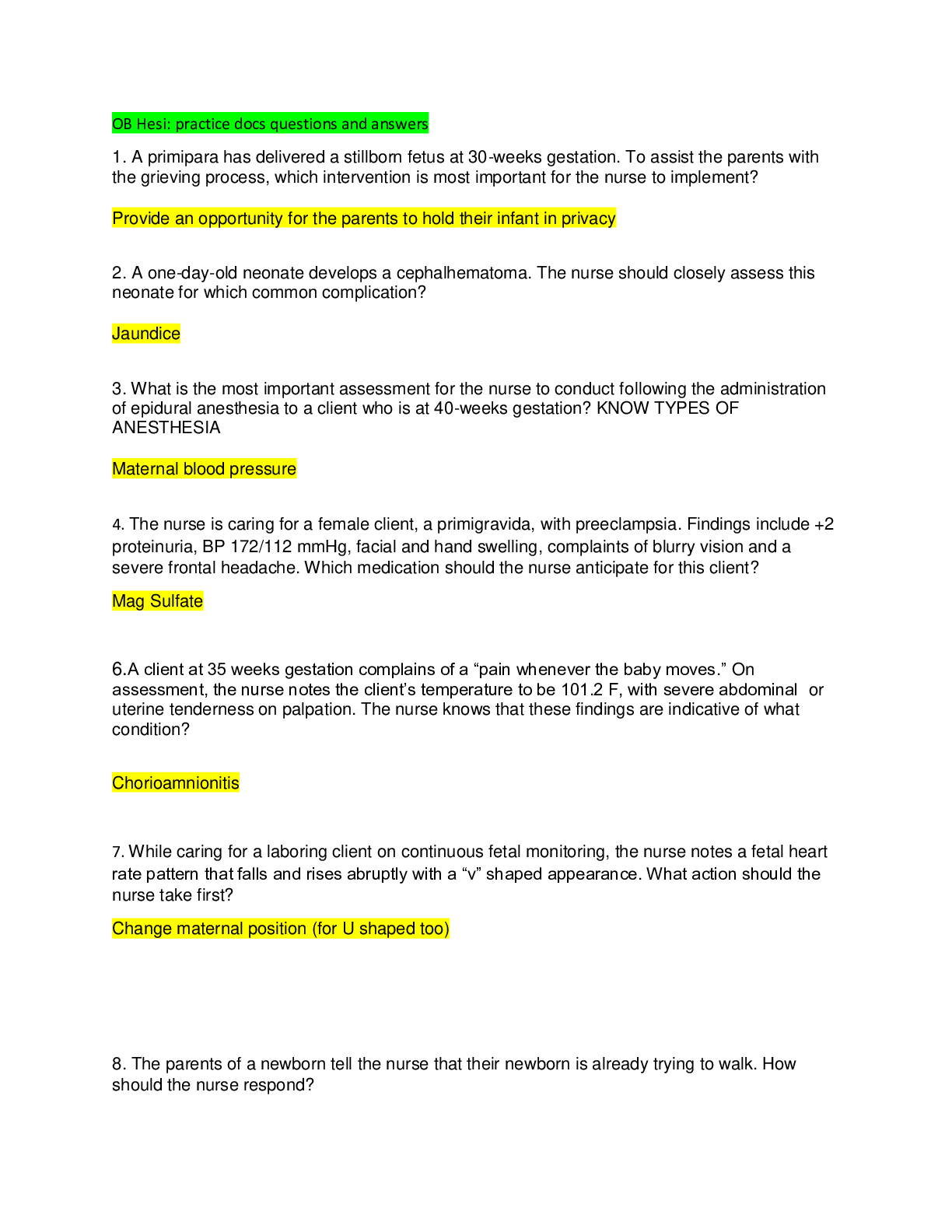
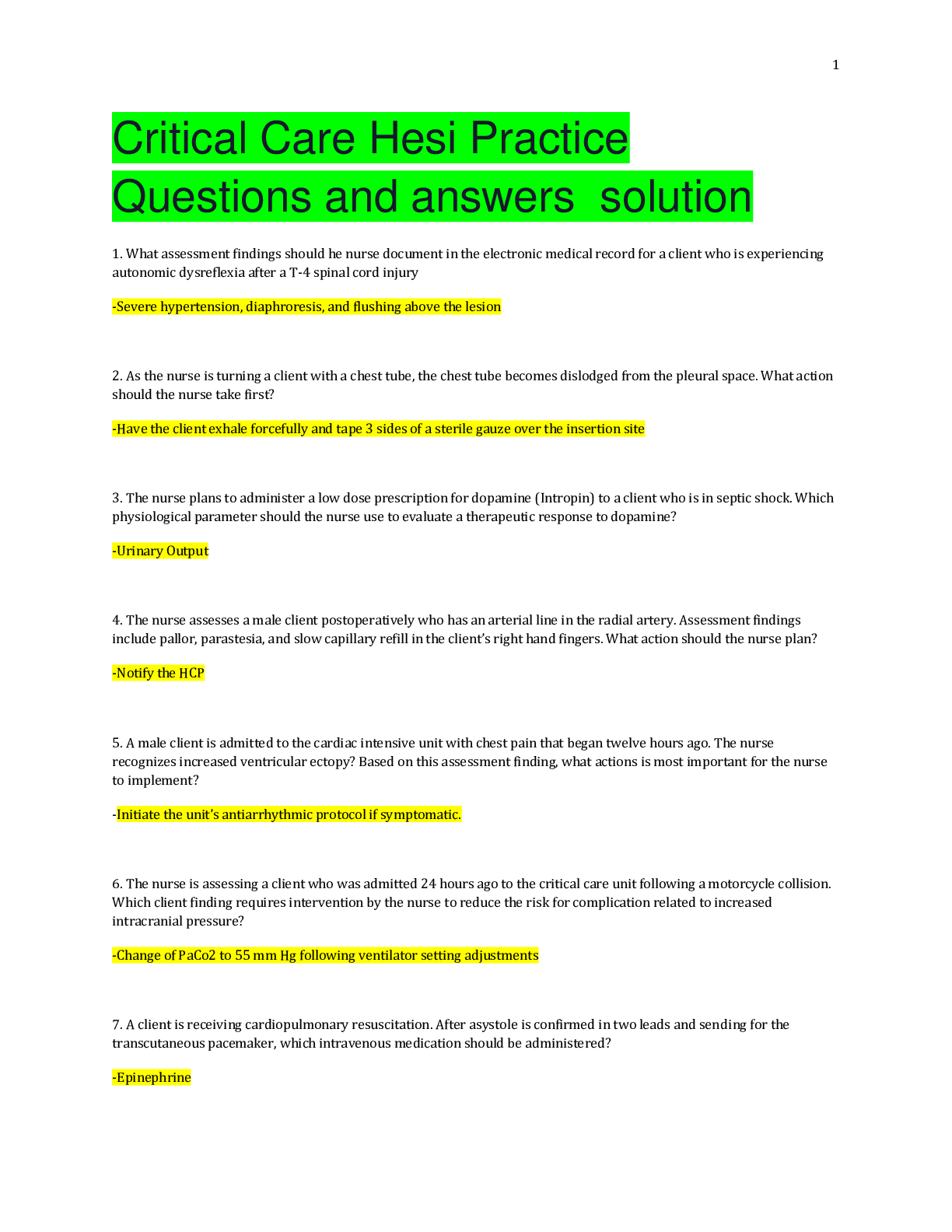
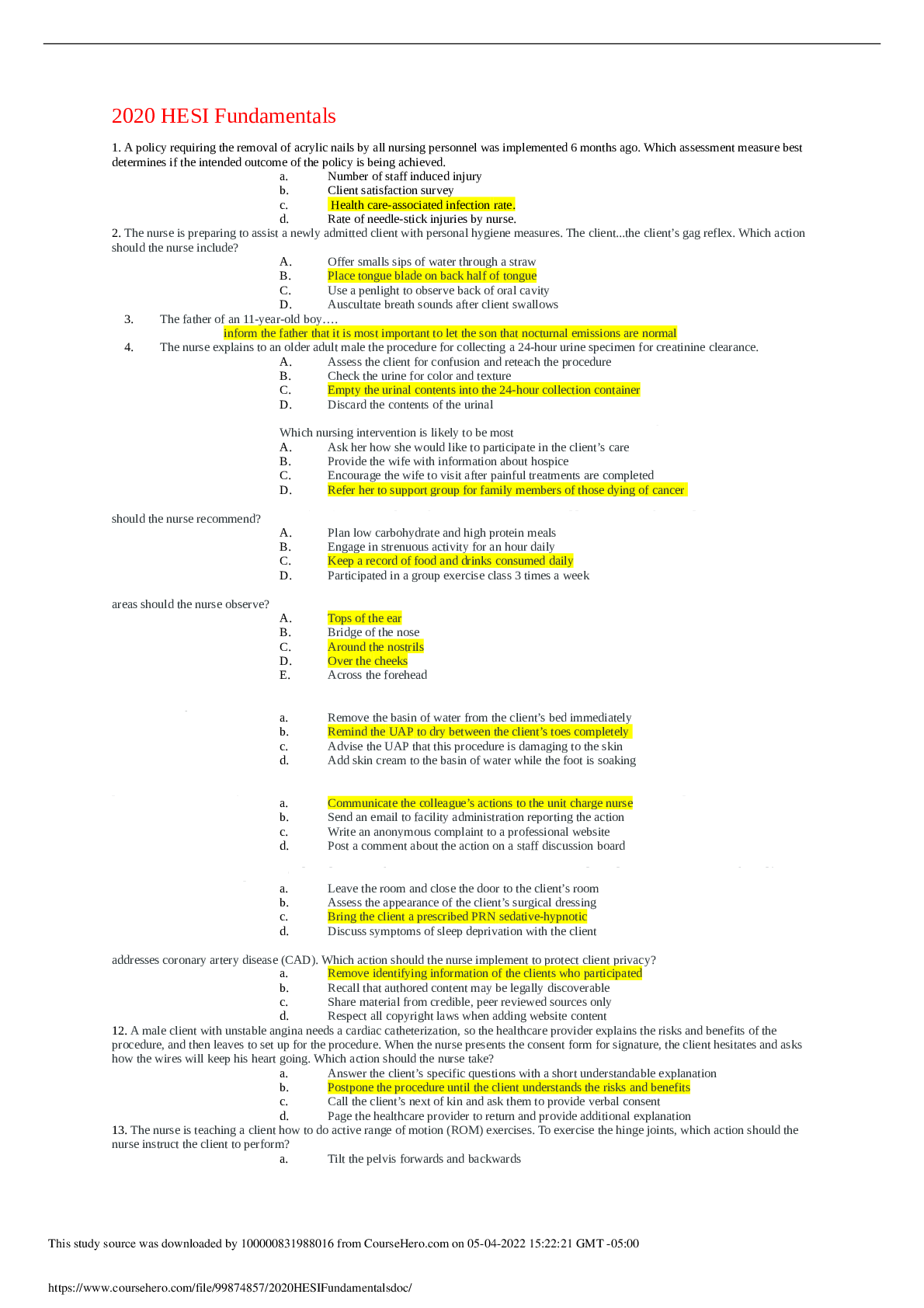

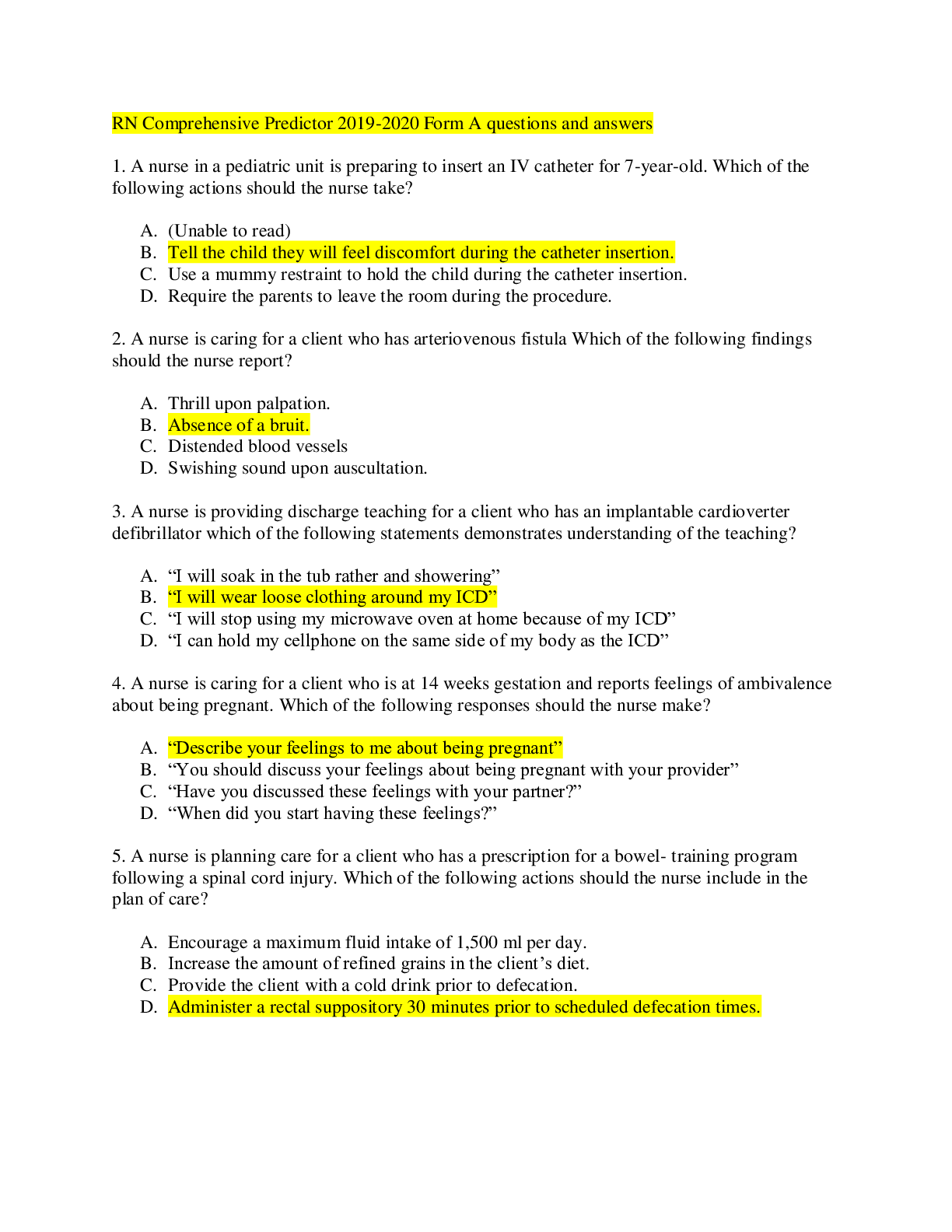

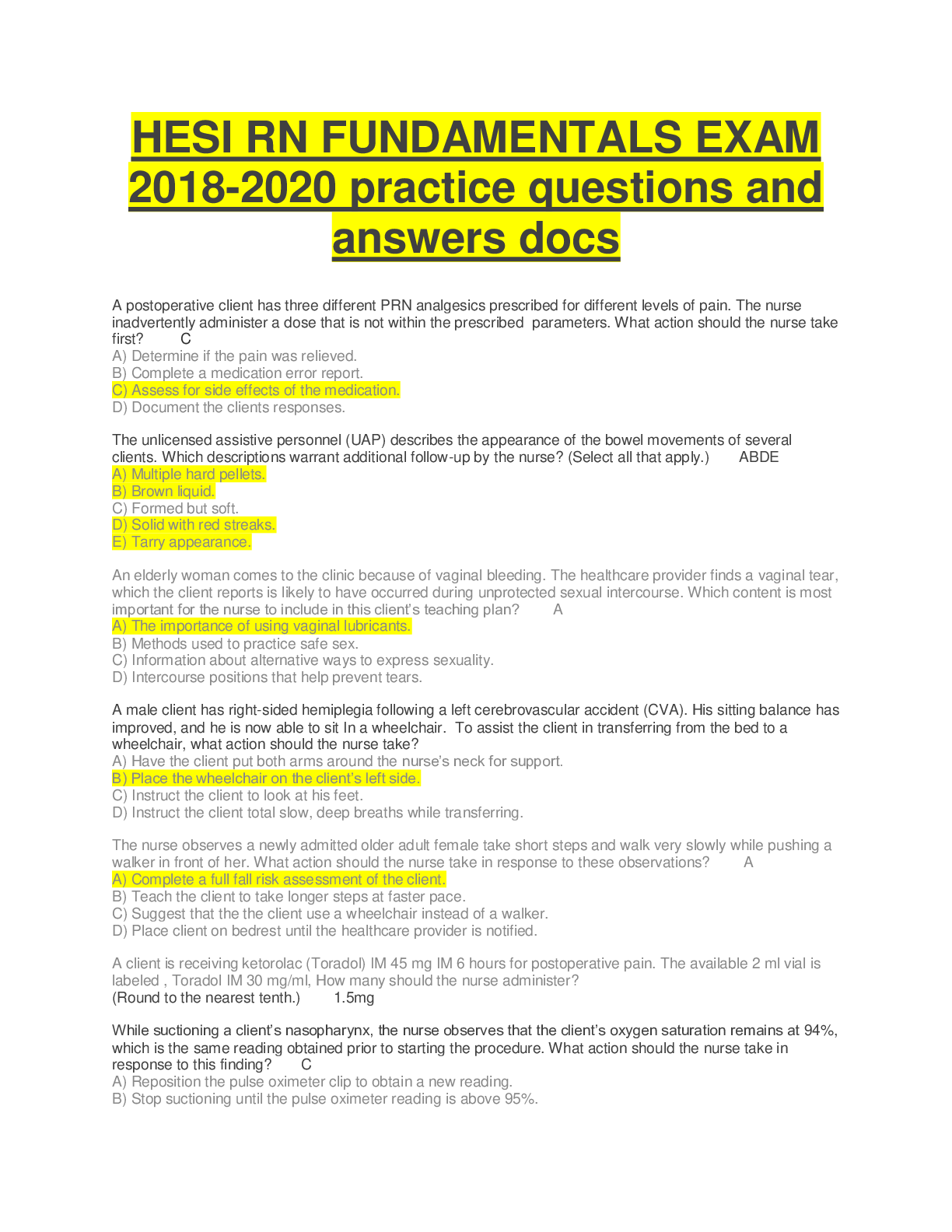
 2020 ans.png)





